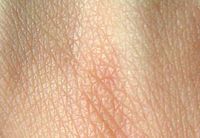
Photo from wikipedia
BackgroundIn mouse skin models, mast cells have been shown to express vitamin D receptor (VDR) that can mediate the immunosuppressive effects of ultravioletBradiation and vitamin D3. However,VDR activation leads to… Click to show full abstract
BackgroundIn mouse skin models, mast cells have been shown to express vitamin D receptor (VDR) that can mediate the immunosuppressive effects of ultravioletBradiation and vitamin D3. However,VDR activation leads to the expression of CYP24A1, a hydroxylase that can inactivate vitamin D3 metabolites.ObjectivesTo examine immunoreactivity to VDR and CYP24A1 in mast cells from normal human skin, keratinocyte skin cancers, and disorders of chronic inflammation.Materials & methodsFrozen biopsies were collected from the non-lesional and lesional skin of patients with actinic keratosis (AK), Bowen’s disease/ squamous cell carcinoma (SCC), basal cell carcinoma (BCC), and psoriasis. The expression of VDR and CYP24A1 in tryptase-positive mast cells was analysed using double-staining methods.ResultsLess than 0.5% of the mast cells were immunoreactive to VDR in both the non-lesional and lesional skin for all disease groups. In non-lesional skin, only 0.5-2.9% of the mast cells were immunopositive for CYP24A1, however, the percentage of mast cells containing CYP24A1 was significantly increased in lesional skin of AK, SCC, and BCC. In contrast to human skin, LAD2 mast cells cultured from a patient with mast cell sarcoma/leukaemia revealed that about 34% and 6.5% of the cells were immunopositive forVDRand CYP24A1, respectively.ConclusionWhereas a very small proportion of mast cells in human skin express VDR and CYP24A1, the proportion of mast cells expressing CYP24A1 in keratinocyte skin cancers is increased; the mechanism underlying this is unclear.
Journal Title: European Journal of Dermatology
Year Published: 2017
Link to full text (if available)
Share on Social Media: Sign Up to like & get
recommendations!